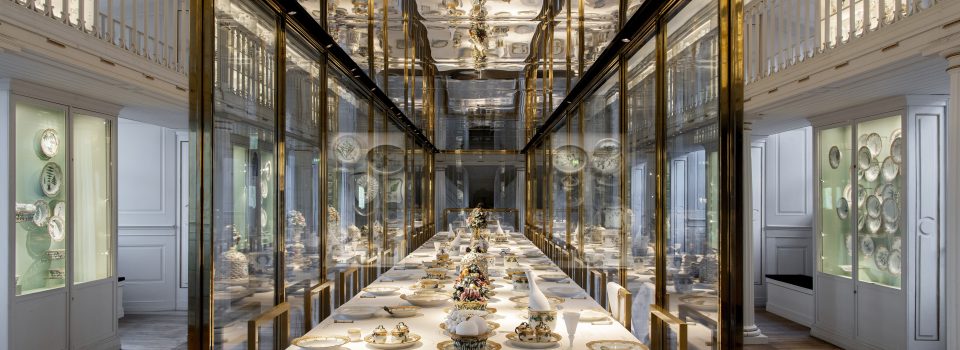
Permanent exhibition
FLORA DANICA – The World’s Wildest Dinnerware
A world of wild luxurious porcelain is revealed when the Royal Danish Collection presents the first public exhibition of the original Flora Danica dinnerware in the Library Hall at Koldinghus.
With 1,530 intact pieces, the Flora Danica dinnerware is not only the best-preserved luxurious porcelain service from the 18th century but also undoubtedly the world’s wildest dinnerware in terms of splendour, storytelling and decorations. This grand exhibition of the Flora Danica dinnerware at Koldinghus offers a close look at the magnificent set and tells the story of the fascinating ideas and myths associated with it and their connections to national and international politics. With its numerous pieces and painstaking reproductions of wild Danish botany on fragile white porcelain, the service offers an important key to understanding Denmark during the Enlightenment. Like the Danish crown jewels, the dinnerware is still in use today for very special occasions in the Royal House.
The origins of Flora Danica
The exhibition explores the origins of this historic porcelain service, which is inextricably linked with Flora Danica, the world’s most ambitious reference work on wild plants, which took more than 122 years to complete and features beautiful copperplate prints and precise descriptions of more than 3,240 plant species.
The goal of the project was both to collect knowledge and facilitate the use of wild plants and to lend lustre to the absolute monarchy, and around 1789, it was decided to transplant this prestigious project to precious porcelain. No specific information has been preserved about when this wild idea first arose, who came up with the almost absurd notion of decorating porcelain with wild plants and for whom this lavish service. Indeed, our knowledge about the early chapters in the story of this magnificent service is as limited as the myths about it are numerous!
Wild rumours and international drama
Even while the service was still in the making, rumours abounded about the purpose of this lavish dinnerware decorated with wild plants. Rumour spread like wildfire throughout Europe, and there was persistent speculation that it was intended for the Russian Empress Catherine the Great, who was a porcelain enthusiast. Indeed, the Flora Danica service may have been intended for her, as a diplomatic gift in a time of international tension. Or perhaps, the dinnerware with the wild plants were created for the table of the Danish king as a wild act of political nudging to promote a particular policy.
At the time, the dramatic state of international politics was easily matched by the drama surrounding the political direction of the monarchy in the Danish realm, where a fierce political battle was playing out between pro- and anti-reformists. The exact role and position of the Flora Danica service in the cross-fire of reforms, diplomacy and wild rumour remain a mystery to this day. Around 1789, that mystery put forth an outstanding flower in the form of this stunning service, unparalleled in scale and wondrous decorations.
Poisonous mushrooms and sophisticated advertising
Each of the many pieces of the Flora Danica service features images from one of the copperplate prints from the reference work, carefully reproduced in full scale. Tureens, wine coolers and plates are covered in wild flora: from humble algae on Norwegian rocks to poisonous mushrooms in Danish forests and long grasses on the moors of Holstein.
While the copperplate images were easily transferred to the larger pieces, such as tureens and serving dishes, the porcelain painters needed all their skill and ingenuity when it came to the smaller pieces. Long stalks were cut, grasses were laid horizontally, and leaves were twisted to fit the floral decorations onto round and curvy small dishes, custard cups and salt cellars. The mantra was accuracy above all else, with correct representations taking precedence over beauty. Thus, despite its impressive volume and splendour, the service was mainly conceived as PR for the underlying publication. In fact, it is so inextricably linked to the reference work that the service should not be seen as an independent artistic achievement by the Royal Danish Porcelain Factory but rather as a sophisticated advertising stunt.
The world’s wildest dinnerware
Since the large exhibition about the Flora Danica dinnerware in 1990 at Christiansborg Palace, it has not been possible to stage a comprehensive presentation of this wild service, which is almost as storied as it is voluminous. The exhibition will shed light on the wild myths surrounding the service and offer the audience an up-close look at the unusual decorations and the use of the historical service, which was first used in 1803 at the birthday banquet for Christian VII.
Since then, it has been used on very special occasions in the Royal House. Most recently, it was in use at the golden jubilee of HM Queen Margrethe II in January 2022. No other Danish service can boast as long a legacy or a presence at such historic banquets as the Flora Danica service, which remains the world’s wildest dinnerware – in terms of history, storytelling and decoration.
The exhibition “FLORA DANICA – The World’s Wildest Dinnerware” was made possible by loans of items from the State Inventory and contributions from Royal Copenhagen and Georg Jensen Damask. The exhibition opens at Koldinghus on 7 October 2022 and will be followed up by events and communication initiatives to shed light on the history, use and continued relevance of the porcelain service.
 Dansk
Dansk
 English
English
 Deutsch
Deutsch
